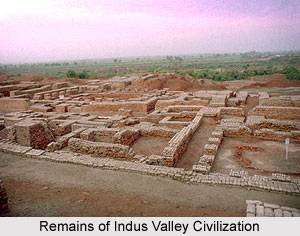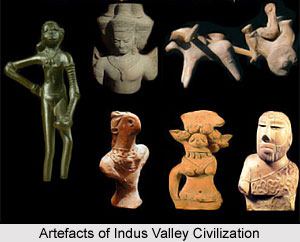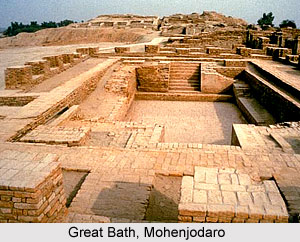 Indus Valley Civilisation is the earliest known civilization of the Indian Subcontinent. According to Wheeler, the famous archaeologist, Indus Valley Civilization had flourished from about 3000 B.C, much before the existence of other civilizations, to 1500 B.C. It is believed that Indus Valley Civilization belonged to the late Neolithic (New Stone Age) Age and Chalcolithic (Copper) Age as the presence of iron tools and implements has not yet been established in any part of this civilization. Indus Valley Civilization was named so as its occurrence was mainly discovered along the banks of Indus River and its tributaries. So far as the origin of the word "Indus" is concerned, Scholars are of the opinion that the name "Indus" is the origin of the word "Hindu." The original Indian name of the river was Sindhu. The ancient Iranians had difficulty in pronouncing an initial sibilant "s" and changed it to an aspirate sound "h", hence, "H-indu" instead of "S-indhu." In ancient times Indians themselves referred to their country as Bharata-varsha (the "land of the sons of Bharata," a ruler). Indus Valley Civilization is also known as Harappan Civilization, owing to the fact that Harappa was the first city discovered in this civilization.
Indus Valley Civilisation is the earliest known civilization of the Indian Subcontinent. According to Wheeler, the famous archaeologist, Indus Valley Civilization had flourished from about 3000 B.C, much before the existence of other civilizations, to 1500 B.C. It is believed that Indus Valley Civilization belonged to the late Neolithic (New Stone Age) Age and Chalcolithic (Copper) Age as the presence of iron tools and implements has not yet been established in any part of this civilization. Indus Valley Civilization was named so as its occurrence was mainly discovered along the banks of Indus River and its tributaries. So far as the origin of the word "Indus" is concerned, Scholars are of the opinion that the name "Indus" is the origin of the word "Hindu." The original Indian name of the river was Sindhu. The ancient Iranians had difficulty in pronouncing an initial sibilant "s" and changed it to an aspirate sound "h", hence, "H-indu" instead of "S-indhu." In ancient times Indians themselves referred to their country as Bharata-varsha (the "land of the sons of Bharata," a ruler). Indus Valley Civilization is also known as Harappan Civilization, owing to the fact that Harappa was the first city discovered in this civilization.
Origin of Indus Valley Civilization
Discovered in 1920, various archaeological researches have suggested that Indus Valley Civilization had marked its origin some 5000 years ago. The two most significant sites of this civilization, namely Harappa and Mohenjodaro, were discovered in the banks of Ravi River and Indus River respectively. It has been estimated that a group of nomadic people from Sumeria, currently known as Iran, had come to northwest India through Mula pass across Himalaya. The rich and fertile land there nourished by the five rivers namely Sutlej, Chenab, Beas, Ravi and Indus, which is the modern day Punjab, influenced them to settle down. As compared to the deserts where they used to dwell, this place was bliss to them with abundance of water and natural resources. Over years, these immigrants spread their settlement along the Indus River which gave rise to Indus Valley Civilization. Indus Valley Civilization was an urban civilization and was a remarkably developed one. Subsequent researches have furnished that, Indus Valley Civilization was not only confined to the Indus Valley but was also spread through the north-western and western parts of India.
 People of Indus Valley Civilization
People of Indus Valley Civilization
The excavations and analyses done so far are not sufficient to reach an exact conclusion about the people of Indus Valley Civilization. Scholars differ in their opinion about the race of Indus people. Researches have furnished that Indus Valley Civilization had been a combination of diverse racial elements. Certain anthropological investigations and examinations of the human remains show that four racial types existed in this civilization namely Proto-Australiod, Mediterranean, Alpinoid and the Mongoloid. The civilization had a rich cultural heritage and evidences suggest that the people of this civilization were literate and had developed a system of writing.
Urban Development in Indus Valley Civilization
Architectural similarities in the twin cities of Harappa and Mohenjodaro confirm the fact that both these cities were parts of the same government. Indus Valley Civilization was urbanized, highly developed and sophisticated. Its stability can be traced up to thousands of years from its origin. The ruins exhibit high level of planning in the cities. Excavations have indicated that the buildings were built with baked bricks. The streets were well constructed at right angles with an elaborate and covered drainage system. Localities were divided clearly and the houses had watermarks for upper and lower classes of society. The civilization also had public buildings including the vast granaries and the Great Bath at Mohenjodaro. Production of metals like bronze, lead, tin and copper can also be traced in this era. Kilns have also been excavated which testify the usage of burnt bricks for the construction of various buildings. People of this civilization were strikingly skilled in artistry.
 Occupation of the people of Indus Valley Civilization
Occupation of the people of Indus Valley Civilization
Cultivation was a fairly popular occupation in the Indus Valley Civilization. Harappans used to cultivate wheat, peas, barley and sesame. Evidences suggest that cotton was cultivated for the first time by Harappans and clothes were made using them. Domestic animals like goats, camels, buffalos and fowls were widely used in the society. Various seals have been found from the ruminants which indicates that trade was another popular activity prevalent in the society. Seals of different shapes and designs, with carvings of animal or human figures, suggest that each merchant had his own seal. Discovery of seals from Ur, Sumeru and other areas of Mesopotamian civilization are indicative of the fact that Harappan people had trade relation with the Mesopotamian people.
Society and Religion of Indus Valley Civilization
Findings and elaborate clues support the fact that Harappan Civilization had an organized form of government to rule the society. The social classes were divided according to the occupation of the people. Various deities were worshipped and their images can be found on the seals. Evidences have also established the practice of several religious ceremonies and rituals. Although, no remains of any monument have been excavated but numerous terracotta statues of Mother Goddess have been found suggesting that Mother Goddess had been worshipped extensively by the Harappan people.
The exact reason behind the decline of Indus Valley Civilization has not yet been confirmed. However several theories have been proposed for its explanation. Many aspects of this civilization are yet to be discovered and further excavations can help to have a better understanding of its extent. The development and urbanization of the civilization at such ancient period is strikingly admirable which had laid the foundation of subsequent civilizations in the country.



















